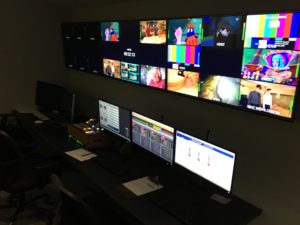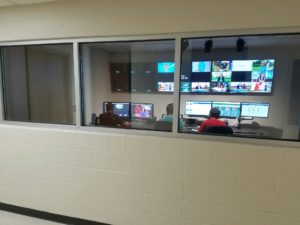By CASSIE SLANA
Senior Writer
(Warrensburg, Mo., digitalBURG) — With recent renovations to KMOS, UCM is working to provide access to the most up-to-date technology for staff and students at the TV station.

PHOTO BY CASSIE SLANA / SENIOR WRITER
Josh Tomlinson, assistant director of technology, said he spearheaded the renovations of the Patton Broadcast Center located on the ground floor of the Wood and Martin buildings. He said the BroadStream Oasys, the station’s new state-of-the-art automation system, replaced five racks worth of equipment in the server room.
“It’s so much more sophisticated and so much more reliable, and the abilities it gives us are great,” he said.
Tomlinson said UCM came across the automation system by chance. He said the radio station WFUM in Flint, Michigan, had purchased a new master control in 2008. The station licensed from a university and was small in comparison to the larger, statewide network. Tomlinson said the larger network eventually absorbed WFUM and, because the new master control had been purchased with a public television grant, the system had to go to another public television station.
“It was $1.1 million worth of equipment at the time, and we bid $50,000, and we got it,” Tomlinson said. “We brought it down here and recommissioned it. That was a Sundance and Omneon system, and that took us into the next century.”
Tomlinson said 3 years later Sundance said it would no longer support that kind of system, as it had gone “end of life.” He said KMOS staff then had to decide how to take action on the situation.
“We sat down and we decided we were going to solve the problem and do whatever we could to make the station better for the campus, for the viewers, for the students,” he said.

PHOTO SUBMITTED BY JOSH TOMLINSON
Student workers in newly renovated KMOS control room.
Tomlinson said while at the National Association of Broadcasters show in April 2015, in Las Vegas, Nevada, the KMOS team came upon a new automation system that could solve the impending issue.
“I looked up some of the usual suspects, Crispin, Pebble Beach and Harmonic, and I was doing cost benefit analysis,” Tomlinson said. “To replace the system, we were looking at $1 million to $1.2 million.”
Tomlinson said he ended up stumbling upon the BroadStream booth, which he had not heard much about because the company was mostly popular in Europe. He said UCM was offered an automator that could do everything the million dollar systems could do for only $400,000. With that amount came five-year support, replaced graphics, an additional channel and an enormous amount of storage for a third of what the other systems had asked for.
“This company has been great to work with because they’ve bent over backwards to make everything work and get everything going,” Tomlinson said. “Just like anything new you buy, you’ve just got to work out the kinks.”
In October 2015, Tomlinson said he presented President Chuck Ambrose with more than 100 pages of information to ask for approval of funding for the renovation of the KMOS systems. Tomlinson said KMOS was approved $603,000 of funding, obtained from the transfer of the university’s on-campus radio station to KCPT in December 2013.
Although the new automation system was the biggest piece of the renovation, the remaining money went to other improvements, including replacing the air conditioning, the installation of compliance monitors, a new transmitter control for communication from transmitters and new power panels. Tomlinson said the power panels were original to the building, making them nearly 40 years old.
Tomlinson said KMOS now has four channels, 6.1, the high-definition primary PBS channel; 6.2, KMOS Create; 6.3, KMOS Worldview, viewed only from this station statewide; 6.4, KMOS World, which will become a 24-hour PBS kids channel in January 2017.
“By expanding to a fourth channel, (viewers) have a variety of programming to watch at any time,” Tomlinson said. “There’s more programming available from KMOS than there ever has been.”
By advancing the technology of an on-campus television station, Tomlinson said it gives students a chance to get their hands on the latest equipment.
“We’ve always been unique in the way we do our master control,” Tomlinson said. “There are a lot of TV stations out there attached to universities that use students in various areas, but there aren’t any that just make the students do the master control work.”
Tomlinson said the students are taking to the new systems well if not better than the older faculty members.



Leave a Reply